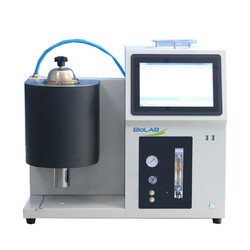
Carbon Residue Tester (Micromethod) BPTL-259
- Sea, Air, Door to Door Shipping
- 1 Year Warranty
- US & European Standards
Petroleum testing is the analysis during upstream, midstream, and downstream production processes of petroleum products. It is most commonly used to test petroleum product, its product components, byproducts of crude oil, fuel, natural gas, upstream oil and gas and other formats of petroleum.
- The instrument is suitable to determine the the amount of carbon residue of petroleum products. This instrument adopts all-in-one structure. It consists of two parts: electrical control chamber and high temperature heating furnace. The design is simple and reasonable. The instrument can also be used to determine the petroleum products composed of distillate oils which carbon residue is lower than 0.10%(m/m). But the specimen shall be sampling to 10%(V/V)distillation residue according to GB/T17144-2021 requirement firstly. There is no statistically significant difference between the measurement results obtained by this instrument and those obtained by Conrad residual carbon method in the range of 0.10% - 25.0% (mass fraction).
Specification
Features
Applications
| Temperature of coke chamber | 500℃ |
| Temperature control accuracy | ±2 ℃ |
| Heating power | 1200W |
| Ambient temperature | 5℃~35℃ |
| Relative humidity | ≤ 85% |
| Power supply | AC(220±10%)V,50Hz |
| Power consumption | ≦1400W |
| Dimension | 600×260×550 mm |
| Net weight | 21 kg |
- The instrument is suitable to determine the the amount of carbon residue of petroleum products. This instrument adopts all-in-one structure. It consists of two parts: electrical control chamber and high temperature heating furnace. The design is simple and reasonable. The instrument can also be used to determine the petroleum products composed of distillate oils which carbon residue is lower than 0.10%(m/m). But the specimen shall be sampling to 10%(V/V)distillation residue according to GB/T17144-2021 requirement firstly. There is no statistically significant difference between the measurement results obtained by this instrument and those obtained by Conrad residual carbon method in the range of 0.10% - 25.0% (mass fraction).
Petroleum Industry, PVC Pipe Industry




